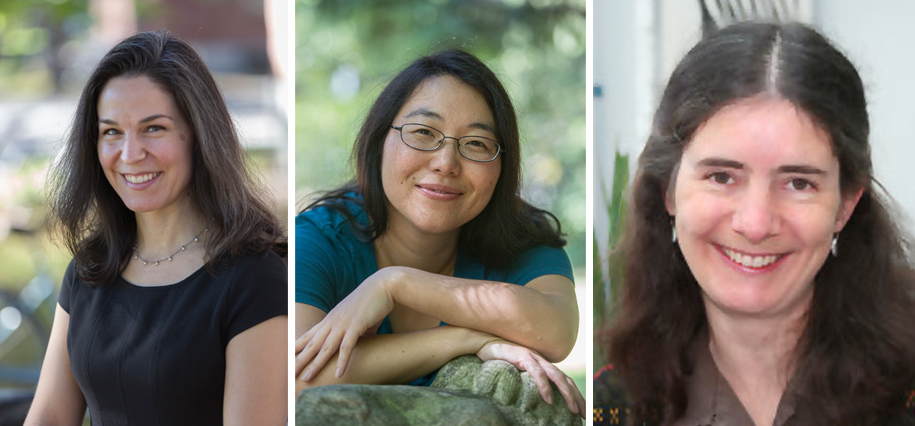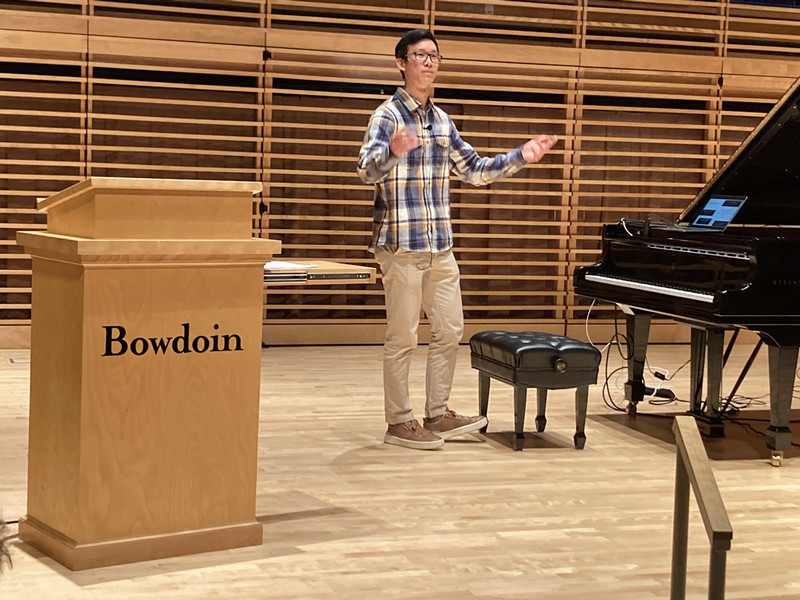Tangible Math: Making a Link Between Clean Numbers and a Messy World
By Philip Kiefer '18




Mathematicians don’t have to live in abstraction. This was the focus of this year’s Dan E. Christie lecture, delivered on Monday night by Catherine Roberts ’87, professor of mathematics at College of the Holy Cross and executive director of the American Mathematical Society.
Her talk, “A River Runs Through It: Math Models in Our World,” focused on building a bridge between a humanistic liberal arts education and mathematical modeling, using Roberts’ own research on Grand Canyon river-runners as an example.
Roberts described her work as “making scientific knowledge useful for practical decision making.” And she credited her time at Bowdoin with allowing her to build a bridge between the “fabric” of mathematics with the ambiguous world of human experience. “While STEM workers can certainly drive innovation through science alone, imagine how much more innovative they could be if the pool of knowledge they draw on were wider and deeper. That occurs as part of a liberal arts education.”
Wherever Roberts looks, she sees mathematical models at work. She hopes to expand the reach of that mathematical research so that society can make better use of the quantitative tools available to it. “That’s the sweet spot for me. I’m very interested in taking mathematics and using it to build a bridge to public policy thinkers,” she said.
“While STEM workers can certainly drive innovation through science alone, imagine how much more innovative they could be if the pool of knowledge they draw on were wider and deeper. That occurs as part of a liberal arts education.”
One of the prime examples of that outreach, she said, is Moon Duchin, a professor of mathematics and “mathematical rock-star” who spoke at Bowdoin in September. Duchin’s work on gerrymandering is likely to play a pivotal role in court decisions in the coming year. Her research addresses deep mathematical and computational problems: there are so many ways to organize the census tracts of Wisconsin into contiguous legislative districts that just the number of combinations, written out, would fill the space of several paragraphs. But she also applies that research to a similarly deep, if less concrete, social question: what does fair representation mean?
Outside of the headlines, Roberts noted that scientists like Mary-Lou Zeeman, Bowdoin’s R. Wells Johnson Professor of Mathematics, are using models to understand the dynamics of global weather patterns, climate change, forest fire cycles, and predator-prey relationships. That research always involves a dizzying amount of collaboration, as everyone from statisticians to physicists to entomologists work together to cobble together an accurate picture of reality.
Roberts has been able to address public policy in her own research, by helping the National Park Service regulate river traffic in the Grand Canyon. When Roberts was a professor at Northern Arizona University, the NPS approached her about creating a model of rafting traffic.
Thousands of boaters travel the Canyon section of the Colorado River every year, some of them on guided trips, and others privately. And every year, more people want to use the river. The NPS wants to preserve the wilderness of the park, and so they closely regulate the number of boaters through a permitting system. By the time Roberts became involved, the waiting list to get an individual permit had grown to over a decade.
The NPS wanted to allow more people to raft the river without overcrowding the river, and so they asked Roberts to help them rethink their permit schedule.
In order to do so, she built a simulation of the river, with current, sandbars, side canyons, and rapids, that would allow planners to understand what conditions led to a crowded river. She spent nearly a decade on the project, including six weeks on the river collecting data on where boaters stopped along the way, how often they saw one another, and where the current created bottlenecks.
“Every year of high school, you learn about lines. But the world is not linear. Models have to be shadows of the real world.”
By simulating thousands and thousands of river seasons, Roberts was able to model the dynamics of river traffic and suggest changes to allow more people to run the canyon each year.
But as powerful as mathematical models can be, they can have drawbacks, Roberts says. That’s part of why thinking about them deeply and broadly is so important. “Every year of high school, you learn about lines,” she said, noting that lines are often the nuts and bolts of modeling. “But the world is not linear. Models have to be shadows of the real world.”
There’s a trade-off inherent in building mathematical models. “We can come up with equations that capture a lot of complexity, but then the math might be so hard that we can’t solve it. But if we simplify the math, we might be ignoring something essential. Like gravity. So finding that sweet spot is really what it’s all about. You want it to be complicated, but not so hard that you can’t solve it.”
NOAA, she said by way of example, calculates roughly 2.8 quadrillion mathematical equations per second (that’s 2,800,000,000,000,000, an infinitesimal fraction of the numbers Moon Duchin, above, work with, for reference). Still, we can barely predict the weather three days in advance.
“If you want to understand the future, this is the best we have. But it’s still not perfect,” she said.



